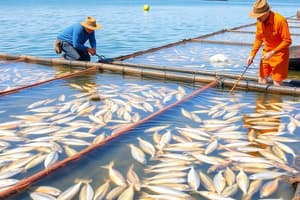Podcast
Questions and Answers
What was the historical state of aquaculture?
What was the historical state of aquaculture?
Aquaculture remained multi-locational and isolated with each location evolving its own pattern/culture practice.
Who were probably the first in the world to culture fish?
Who were probably the first in the world to culture fish?
The Egyptians.
What type of fish did the ancient Egyptians culture?
What type of fish did the ancient Egyptians culture?
- Tilapia (correct)
- Catfish
- Goldfish
- Trout
What period witnessed worldwide expansion in aquaculture operations?
What period witnessed worldwide expansion in aquaculture operations?
Ghana's per capita fish consumption is approximately 25 kg per year.
Ghana's per capita fish consumption is approximately 25 kg per year.
In what year was the first hatchery established in Ghana?
In what year was the first hatchery established in Ghana?
Match the following historical milestones to their dates:
Match the following historical milestones to their dates:
What were the selected species for culture in Africa?
What were the selected species for culture in Africa?
Aquaculture in Latin America has a long-standing local tradition.
Aquaculture in Latin America has a long-standing local tradition.
Flashcards are hidden until you start studying
Study Notes
History of Aquaculture
- Aquaculture has a long history, initially characterized by localized practices unique to each region.
- Advances in communication and travel have standardized practices in aquaculture across different locations.
Milestones in Aquaculture Development
- Egyptians are the earliest known practitioners of fish culture, with evidence dating to 2500 B.C., specifically with tilapia in artificial ponds.
- Romans utilized circular ponds divided into breeding areas for fish farming.
- China spread carp culture around 2000 B.C., with Indian records from 1127 A.D. describing pond fish fattening techniques.
Regional Practices
- Chinese emigrants brought carp cultivation knowledge to Southeast Asia.
- In the Philippines, brackish water fish culture has a long-standing tradition.
- Eel culture has ancient roots in Japan.
Aquaculture in Africa
- European attempts to introduce aquaculture in Africa faced challenges due to nomadic lifestyles and the availability of natural environments promoting the growth of indigenous species.
- Currently, tilapia, common carp, and catfish are popular species for culture across various African nations.
Aquaculture in Latin America
- This region lacks a native tradition of aquaculture but is witnessing increasing interest and development activities.
Aquaculture in Australia and New Zealand
- Aquaculture is just beginning to develop, focusing on species such as trout and various molluscs, including mussels and oysters.
Aquaculture in the Middle East and Israel
- Historical records in this area show limited early aquaculture activity despite rivers; however, current developments, particularly in Israel, have seen successful culture of carp and tilapia.
Aquaculture in Japan and Korea
- Ancient aquaculture practices in these countries were influenced by Chinese methods, particularly with goldfish and carp.
- High-value aquatic species, including finfishes, crustaceans, and marine invertebrates, are extensively cultivated along with valuable aquatic plants.
Period of Expansion (1700–1900)
- This era marked significant global expansion, technological advancements in seed production, and the development of induced spawning techniques for various cultivable species.
Continued Development (1970–Near Future)
- The focus is on selective culture of high-value species and expansion in production quantities, with a notable trend towards maintaining product quality amid increasing market competition.
Aquaculture in Ghana
- Ghana's fish consumption is significant, with animal protein contributing 60% of dietary intake; per capita fish consumption is about 25 kg per year.
- Aquaculture started in Ghana in 1953, with a government initiative in 1970 introducing Nile tilapia to enhance fish production.
Challenges and Progress in Ghana
- Early promotion in the 1980s led to a "mad rush" for aquaculture, resulting in many failures due to inadequate support.
- Surviving farms shifted to small-scale operations utilizing low technology and polyculture methods.
- Between 1990 and 2004, fingerling production technology improved significantly, and the introduction of induced breeding for African catfish aided farmers.
Breakthroughs in Ghana's Aquaculture
- Tropo Farms pioneered commercial pond culture in 2000 using quality fingerlings and aerated feed.
- Crystal Lake began all-male tilapia cage farming on the Volta Lake in 2001.
- The establishment of the Ministry of Fisheries in 2005 marked a renewed focus on aquaculture development.
Studying That Suits You
Use AI to generate personalized quizzes and flashcards to suit your learning preferences.




